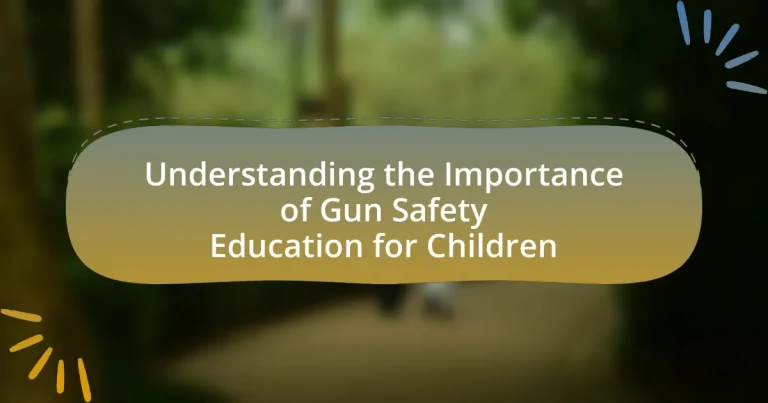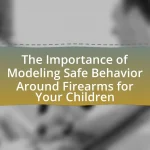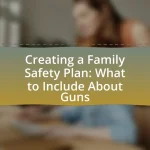Gun Safety Education for Children is a crucial program aimed at teaching children the principles of firearm safety, including recognizing firearms, the importance of not touching them, and seeking adult help if they encounter a gun. This education is vital in reducing accidental shootings and promoting responsible behavior around firearms, as evidenced by research indicating that children who receive such training are less likely to engage in risky behaviors. The article highlights the importance of gun safety education, supported by alarming statistics on firearm-related injuries among children, and outlines effective strategies for parents, educators, and communities to implement comprehensive gun safety programs tailored to different age groups. Additionally, it addresses the challenges and misconceptions surrounding gun safety education, emphasizing the need for open communication and community involvement to foster a culture of safety.
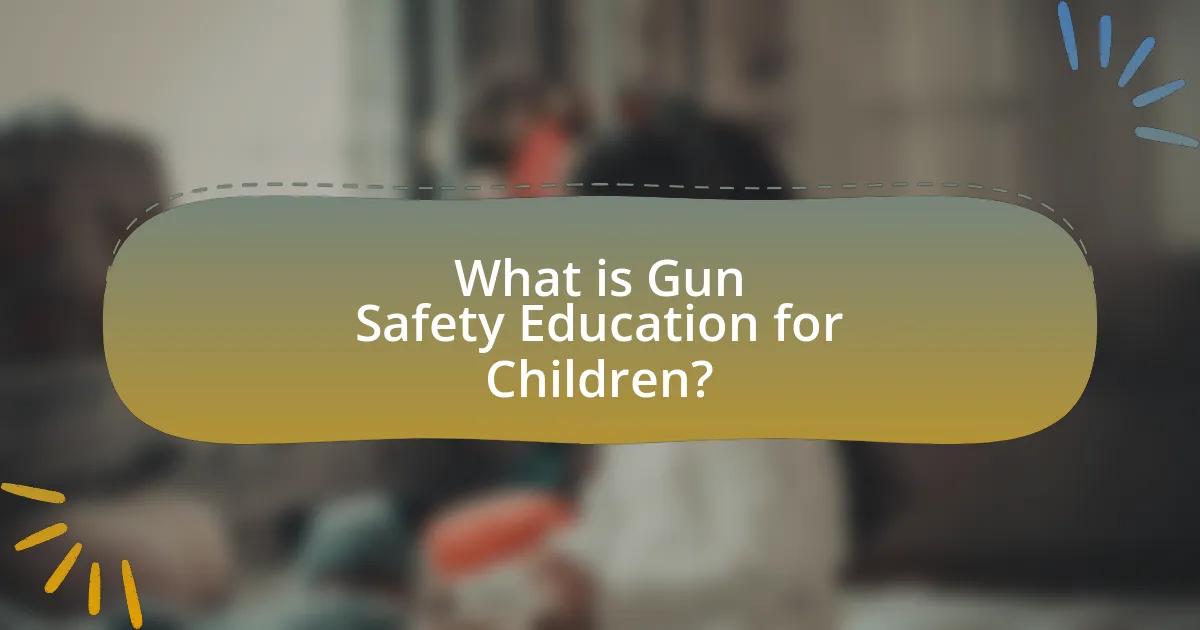
What is Gun Safety Education for Children?
Gun Safety Education for Children is a program designed to teach children the principles of firearm safety, including how to recognize firearms, the importance of not touching them, and how to seek help from an adult if they encounter a gun. This education aims to reduce the risk of accidental shootings and promote responsible behavior around firearms. Research indicates that children who receive gun safety education are less likely to engage in risky behaviors related to firearms, highlighting the effectiveness of such programs in preventing accidents.
Why is Gun Safety Education important for children?
Gun safety education is important for children because it equips them with the knowledge and skills to recognize and respond appropriately to firearms, reducing the risk of accidental shootings. Studies indicate that children who receive gun safety education are less likely to engage in risky behaviors around guns, as they learn the importance of treating every gun as if it is loaded and the necessity of reporting any found firearms to an adult. According to the National Safety Council, proper education can significantly decrease the likelihood of firearm-related accidents among children, highlighting the critical role of such education in promoting safety and awareness.
What statistics highlight the need for gun safety education?
Statistics indicate a significant need for gun safety education, as unintentional firearm injuries are a leading cause of death among children. In the United States, approximately 1,300 children aged 0-17 are killed by guns each year, according to the Centers for Disease Control and Prevention (CDC). Furthermore, a study published in the journal “Pediatrics” found that nearly 1 in 3 households with children have at least one gun, and among those households, 43% of guns are stored unlocked. These figures underscore the critical importance of educating children about gun safety to prevent accidents and fatalities.
How does gun safety education impact children’s behavior around firearms?
Gun safety education significantly improves children’s behavior around firearms by instilling knowledge and awareness about the dangers associated with guns. Research indicates that children who receive formal gun safety training are less likely to engage in risky behaviors, such as handling firearms unsupervised. A study published in the journal “Pediatrics” found that children who participated in gun safety programs demonstrated a 70% reduction in unsafe handling of firearms compared to those who did not receive such education. This evidence underscores the effectiveness of structured gun safety education in promoting responsible behavior and reducing accidents involving firearms among children.
What are the key components of effective gun safety education?
The key components of effective gun safety education include understanding the four fundamental rules of gun safety, recognizing the importance of secure storage, and promoting open communication about firearms. The four fundamental rules are: always treat every gun as if it is loaded, never point a gun at anything you do not intend to shoot, keep your finger off the trigger until ready to shoot, and be sure of your target and what is beyond it. Secure storage is crucial, as studies show that 73% of children who live in homes with firearms report knowing where the guns are kept, highlighting the need for safe storage practices to prevent unauthorized access. Open communication encourages children to ask questions and express concerns about firearms, fostering a safe environment where they can learn about the dangers and responsibilities associated with guns.
What topics should be covered in gun safety education programs?
Gun safety education programs should cover topics such as the basic mechanics of firearms, safe handling practices, the importance of secure storage, recognizing and avoiding dangerous situations, and understanding the legal responsibilities associated with gun ownership. These topics are essential as they provide foundational knowledge that can prevent accidents and promote responsible behavior around firearms. For instance, studies indicate that proper education on safe storage can significantly reduce the risk of unintentional shootings among children, highlighting the critical need for comprehensive training in these areas.
How can parents and educators effectively teach gun safety?
Parents and educators can effectively teach gun safety by implementing structured educational programs that emphasize the importance of responsible firearm handling. These programs should include age-appropriate discussions about the dangers of guns, safe storage practices, and the importance of reporting any gun-related incidents to an adult. Research indicates that children who receive formal gun safety education are less likely to engage in unsafe behaviors around firearms. For instance, a study published in the Journal of Pediatrics found that children who participated in gun safety training demonstrated a 70% reduction in unsafe handling of firearms compared to those who did not receive such training. This evidence underscores the effectiveness of proactive education in fostering a culture of safety around guns.
What age-appropriate strategies exist for teaching gun safety?
Age-appropriate strategies for teaching gun safety include using age-specific language, interactive activities, and role-playing scenarios. For young children, simple concepts like “stop, don’t touch, run away, tell an adult” can be effective, while older children can engage in discussions about the responsibilities of gun ownership and the importance of reporting unsafe situations. Research indicates that children who receive structured gun safety education are less likely to engage in risky behaviors around firearms, highlighting the effectiveness of these strategies in reducing accidents and promoting safety awareness.
How can gun safety education be tailored for different age groups?
Gun safety education can be tailored for different age groups by adjusting the complexity of the information and the methods of delivery. For young children, education should focus on basic concepts such as recognizing firearms, understanding that guns are not toys, and promoting the importance of telling an adult if they encounter a gun. This can be achieved through interactive storytelling and age-appropriate games that emphasize safety.
For pre-teens, the curriculum can introduce more detailed discussions about the dangers of firearms, safe handling practices, and the responsibilities that come with gun ownership. Role-playing scenarios can be effective in helping this age group understand how to react in situations involving guns.
Teenagers can benefit from a more comprehensive approach that includes discussions about the legal aspects of gun ownership, the consequences of gun violence, and peer pressure related to firearms. Workshops that involve hands-on training with safety equipment and discussions about real-life incidents can enhance their understanding and responsibility.
Research indicates that tailored educational programs significantly improve knowledge retention and safety practices among children and adolescents. For instance, a study published in the Journal of Safety Research found that children who participated in age-appropriate gun safety programs demonstrated a 50% increase in knowledge retention compared to those who did not receive such education.
What methods engage children in learning about gun safety?
Interactive methods such as hands-on activities, role-playing scenarios, and educational games effectively engage children in learning about gun safety. These approaches allow children to actively participate in the learning process, making the information more relatable and memorable. For instance, programs like the Eddie Eagle GunSafe Program utilize animated characters and storytelling to teach children the “Stop! Don’t Touch! Run Away! Tell a Grown-Up!” message, which has been shown to improve retention of safety principles. Additionally, workshops that involve parents and children together foster open discussions about gun safety, reinforcing the lessons learned in a supportive environment.

How can communities promote gun safety education for children?
Communities can promote gun safety education for children by implementing structured programs that teach safe handling and awareness of firearms. These programs can include workshops, school curricula, and community events that engage children in interactive learning experiences about gun safety. For instance, the National Rifle Association (NRA) offers the Eddie Eagle GunSafe Program, which has reached millions of children with its message of “Stop! Don’t Touch. Run Away. Tell a Grown-Up,” effectively educating them on how to react if they encounter a firearm. Additionally, local law enforcement agencies can collaborate with schools to provide demonstrations and resources, reinforcing the importance of safety and responsible behavior around guns.
What role do schools play in gun safety education?
Schools play a crucial role in gun safety education by providing structured programs that teach students about the dangers of firearms and the importance of responsible behavior. These educational initiatives often include age-appropriate lessons on recognizing firearms, understanding the consequences of gun violence, and knowing how to react in situations involving guns. Research indicates that programs like the Eddie Eagle GunSafe Program, developed by the National Rifle Association, have been effective in reducing accidental shootings among children by promoting awareness and safety practices. By integrating gun safety education into their curricula, schools contribute to a safer environment and empower students with knowledge that can prevent tragic incidents.
How can schools integrate gun safety into their curricula?
Schools can integrate gun safety into their curricula by incorporating structured educational programs that focus on safe handling, storage, and the legal responsibilities associated with firearms. These programs can include age-appropriate lessons, interactive workshops, and partnerships with local law enforcement or gun safety organizations to provide expert instruction. Research indicates that educational interventions can significantly reduce accidental shootings and promote responsible behavior among youth, as evidenced by studies showing a decrease in firearm-related incidents in communities that have implemented such programs.
What partnerships can schools form to enhance gun safety education?
Schools can form partnerships with local law enforcement agencies, community organizations, and mental health professionals to enhance gun safety education. Collaborating with law enforcement can provide students with firsthand knowledge about gun safety protocols and the legal implications of gun ownership. Community organizations, such as the National Rifle Association’s Eddie Eagle GunSafe Program, offer structured educational resources that teach children about gun safety in an engaging manner. Additionally, mental health professionals can contribute by addressing the psychological aspects of gun safety, helping students understand the importance of reporting unsafe situations. These partnerships can create a comprehensive approach to gun safety education, ensuring that students receive accurate information and support from multiple trusted sources.
How can community organizations support gun safety education?
Community organizations can support gun safety education by providing resources, training programs, and outreach initiatives aimed at teaching safe firearm handling and storage practices. These organizations can collaborate with local law enforcement and educational institutions to develop workshops that educate families about the risks associated with firearms and the importance of secure storage. For instance, studies show that proper gun storage can reduce accidental shootings among children by up to 73%. By facilitating community events and distributing educational materials, organizations can effectively raise awareness and promote responsible gun ownership, ultimately contributing to safer environments for children.
What programs can local organizations implement to promote gun safety?
Local organizations can implement community-based gun safety education programs to promote gun safety. These programs can include workshops that teach children and parents about safe handling, storage, and the importance of reporting unsafe situations. For instance, the Eddie Eagle GunSafe Program, developed by the National Rifle Association, provides educational materials aimed at children to prevent firearm accidents. Research indicates that such educational initiatives can significantly reduce the incidence of unintentional shootings among children, highlighting their effectiveness in promoting safety.
How can community events raise awareness about gun safety for children?
Community events can effectively raise awareness about gun safety for children by providing interactive educational experiences that engage families. These events often include workshops, demonstrations, and discussions led by experts in gun safety, which help to convey critical information in an accessible manner. For instance, the National Shooting Sports Foundation reports that community programs that incorporate hands-on activities, such as safety drills and role-playing scenarios, significantly enhance children’s understanding of safe behaviors around firearms. Additionally, these events foster a supportive environment where parents can learn alongside their children, reinforcing the importance of communication about gun safety at home.
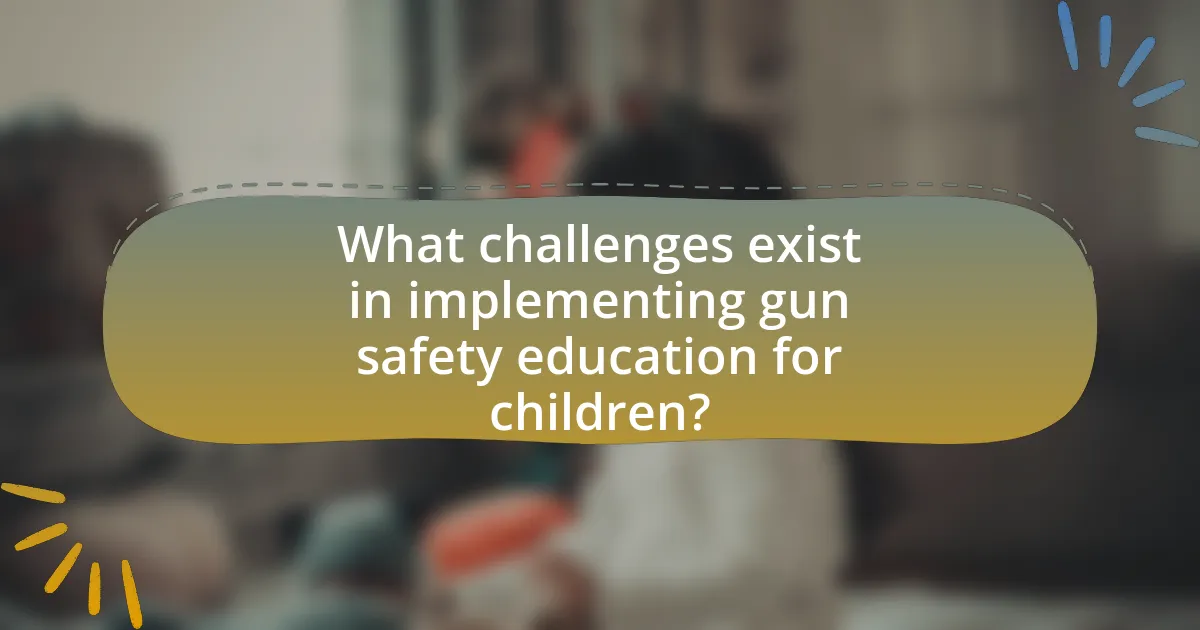
What challenges exist in implementing gun safety education for children?
Implementing gun safety education for children faces several challenges, including varying levels of parental support, cultural attitudes towards firearms, and the availability of resources. Parental support is crucial, as some parents may oppose gun safety education due to personal beliefs or lack of understanding of its importance. Cultural attitudes can also hinder implementation; in communities where gun ownership is prevalent, there may be resistance to discussing gun safety openly. Additionally, resources such as trained educators and age-appropriate materials are often limited, making it difficult to provide comprehensive education. According to a study published in the Journal of Community Health, effective gun safety education requires community engagement and support, highlighting the need for tailored approaches to address these challenges.
What misconceptions about gun safety education need to be addressed?
Misconceptions about gun safety education that need to be addressed include the belief that such education promotes gun use among children. In reality, studies show that comprehensive gun safety education aims to reduce accidents and promote responsible behavior. For instance, research published in the Journal of Pediatrics indicates that children who receive proper gun safety training are less likely to engage in unsafe behaviors around firearms. Another misconception is that gun safety education is unnecessary if there are no guns in the home; however, statistics reveal that many children encounter firearms outside their homes, making education crucial regardless of home circumstances. Addressing these misconceptions is vital for fostering a culture of safety and responsibility regarding firearms among children.
How can misinformation about firearms affect children’s safety?
Misinformation about firearms can significantly compromise children’s safety by leading to misunderstandings about gun handling and storage. When children receive inaccurate information, they may underestimate the dangers associated with firearms, increasing the likelihood of accidental shootings. For instance, a study published in the journal “Pediatrics” found that children exposed to misleading messages about gun safety were more likely to engage in risky behaviors around firearms, such as handling guns without adult supervision. This highlights the critical need for accurate gun safety education to ensure children understand the real risks and appropriate safety measures.
What barriers do parents face in discussing gun safety with children?
Parents face several barriers in discussing gun safety with children, including discomfort with the topic, lack of knowledge, and fear of stigmatization. Many parents feel uneasy addressing gun safety due to personal beliefs or past experiences with firearms, which can hinder open communication. Additionally, a significant number of parents may lack adequate knowledge about gun safety practices, making it challenging to convey important information effectively. Research indicates that only 30% of parents have discussed gun safety with their children, highlighting a gap in awareness and education. Furthermore, parents may fear that discussing guns could lead to stigmatization or conflict within their communities, particularly in areas where gun ownership is prevalent. These factors collectively contribute to the reluctance of parents to engage in necessary conversations about gun safety with their children.
How can advocates overcome resistance to gun safety education?
Advocates can overcome resistance to gun safety education by employing community engagement strategies that foster open dialogue and build trust. By organizing workshops and informational sessions that include parents, educators, and local leaders, advocates can address misconceptions and highlight the importance of gun safety in preventing accidents. Research indicates that community-based programs, such as those implemented by the National Shooting Sports Foundation, have successfully increased awareness and acceptance of gun safety measures, demonstrating that education can lead to a more informed public.
What strategies can be used to engage skeptical parents and communities?
To engage skeptical parents and communities regarding gun safety education for children, it is essential to utilize transparent communication and community involvement strategies. Establishing open dialogues through community forums allows parents to voice concerns and ask questions, fostering trust and understanding. Additionally, providing evidence-based information, such as statistics showing the effectiveness of gun safety education in reducing accidents, can help alleviate fears. For instance, research from the American Academy of Pediatrics indicates that education programs can significantly lower the risk of firearm-related injuries among children. Collaborating with local organizations and schools to host workshops or informational sessions can further enhance community engagement and demonstrate a commitment to safety.
How can success stories be used to promote gun safety education?
Success stories can effectively promote gun safety education by illustrating real-life examples of how proper education has prevented accidents and saved lives. For instance, programs like the Eddie Eagle GunSafe Program have reported significant reductions in unintentional firearm injuries among children in communities that implemented the curriculum. These narratives not only provide relatable scenarios but also reinforce the importance of responsible gun ownership and safe practices. By showcasing tangible outcomes, such as increased awareness and behavioral changes in children, success stories serve as powerful testimonials that encourage families to engage in gun safety education initiatives.
What practical tips can parents use to teach gun safety at home?
Parents can teach gun safety at home by implementing clear rules, engaging in open discussions, and using educational resources. Establishing rules such as “never touch a gun without adult supervision” helps set boundaries. Open discussions about the dangers of firearms and the importance of safety can foster understanding. Utilizing educational resources like books and videos specifically designed for children can reinforce these lessons. According to the National Safety Council, proper education and communication significantly reduce the risk of firearm accidents among children.
How can parents create a safe environment for discussions about firearms?
Parents can create a safe environment for discussions about firearms by establishing open communication and setting clear guidelines. Open communication encourages children to express their thoughts and concerns without fear of judgment, fostering trust. Setting clear guidelines involves defining acceptable topics, ensuring discussions remain respectful, and emphasizing the importance of safety. Research indicates that children who engage in open dialogues about firearms are more likely to understand safety protocols, reducing the risk of accidents. For instance, a study published in the Journal of Pediatrics found that children educated about gun safety are less likely to engage in risky behaviors around firearms.
What resources are available for parents to educate their children on gun safety?
Parents can access various resources to educate their children on gun safety, including the National Rifle Association’s Eddie Eagle GunSafe Program, which provides educational materials and safety tips for children. Additionally, organizations like the American Academy of Pediatrics offer guidelines and resources for discussing gun safety with children. The Centers for Disease Control and Prevention also provides information on safe storage practices and the importance of supervision. These resources are designed to help parents instill safe behaviors and awareness regarding firearms in their children.
